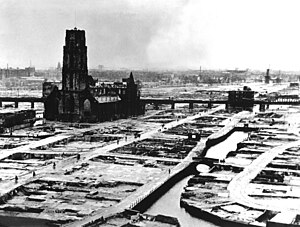Fortress Holland
| Battle of the Netherlands | |||||||
|---|---|---|---|---|---|---|---|
| Part of the Battle of France | |||||||
 The centre of Rotterdam destroyed after bombing |
|||||||
|
|||||||
| Belligerents | |||||||
|
|
|
||||||
| Commanders and leaders | |||||||
|
|
|
||||||
| Strength | |||||||
| 9 divisions 700 guns 1 tank 5 tankettes 32 armoured cars 145 aircraft Total: 280,000 men |
22 divisions 1378 guns 759 tanks 830 aircraft 6 armoured trains Total: 750,000 men |
||||||
| Casualties and losses | |||||||
| 2332 KIA (Dutch Army) 7000 wounded 216 French KIA 43 British KIA Over 2000 civilians killed |
2032 KIA 6000–7000 wounded 4 armoured trains 225–275 aircraft total loss 1350 prisoners to England |
||||||
Decisive German victory
The Battle of the Netherlands (Dutch: Slag om Nederland) was part of Case Yellow (German: Fall Gelb), the German invasion of the Low Countries (Belgium, Luxembourg, and the Netherlands) and France during World War II. The battle lasted from 10 May 1940 until the surrender of the main Dutch forces 14 May. Dutch troops in the province of Zealand continued to resist the Wehrmacht until 17 May when Germany completed its occupation of the whole nation.
The Battle of the Netherlands saw one of the first mass paratroop drops, to occupy tactical points to assist the advance of ground troops. The German Luftwaffe used paratroopers in the capture of several important airfields in the Netherlands in the vicinity of Rotterdam and The Hague, quickly to overrun the nation and immobilise Dutch forces.
After the devastating bombing of Rotterdam by the Luftwaffe, the Germans threatened to bomb other Dutch cities if the Dutch forces refused to surrender. The General Staff knew it could not stop the bombers and ordered the Dutch army cease hostilities to avoid the threat. The last occupied parts of the Netherlands were liberated in 1945.
The United Kingdom and France declared war on Germany in 1939, following the German invasion of Poland, but no major land operations occurred in Western Europe during the period known as the Phoney War in the winter of 1939–1940. During this time, the British and French built up their forces in expectation of a long war, and the Germans completed their conquest of Poland. On 9 October, Adolf Hitler ordered plans to be made for an invasion of the Low Countries, to use them as a base against Great Britain and to pre-empt a similar attack by the Allied forces, which could threaten the vital Ruhr Area.
...
Wikipedia
